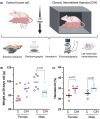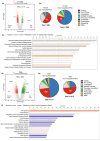Sex differences in cardiac transcriptomic response to neonatal sleep apnea
- PMID: 38981849
- PMCID: PMC11233197
- DOI: 10.14814/phy2.16110
Sex differences in cardiac transcriptomic response to neonatal sleep apnea
Abstract
Pediatric obstructive sleep apnea poses a significant health risk, with potential long-term consequences on cardiovascular health. This study explores the dichotomous nature of neonatal cardiac response to chronic intermittent hypoxia (CIH) between males and females, aiming to fill a critical knowledge gap in the understanding of sex-specific cardiovascular consequences of sleep apnea in early life. Neonates were exposed to CIH until p28 and underwent comprehensive in vivo physiological assessments, including whole-body plethysmography, treadmill stress-tests, and echocardiography. Results indicated that male CIH rats weighed 13.7% less than age-matched control males (p = 0.0365), while females exhibited a mild yet significant increased respiratory drive during sleep (93.94 ± 0.84 vs. 95.31 ± 0.81;p = 0.02). Transcriptomic analysis of left ventricular tissue revealed a substantial sex-based difference in the cardiac response to CIH, with males demonstrating a more pronounced alteration in gene expression compared to females (5986 vs. 3174 genes). The dysregulated miRNAs in males target metabolic genes, potentially predisposing the heart to altered metabolism and substrate utilization. Furthermore, CIH in males was associated with thinner left ventricular walls and dysregulation of genes involved in the cardiac action potential, possibly predisposing males to CIH-related arrhythmia. These findings emphasize the importance of considering sex-specific responses in understanding the cardiovascular implications of pediatric sleep apnea.
Keywords: CIH; autonomic imbalance; cardiac miRNA expression; cardiac remodeling; chronic intermittent hypoxia; transcription.
© 2024 The Author(s). Physiological Reports published by Wiley Periodicals LLC on behalf of The Physiological Society and the American Physiological Society.
Conflict of interest statement
The authors declare that they have no conflict of interest.
Figures





References
-
- Aljadeff, G. , Gozal, D. , Schechtman, V. L. , Burrell, B. , Harper, R. M. , & Ward, S. L. (1997). Heart rate variability in children with obstructive sleep apnea. Sleep, 20(2), 151–157. - PubMed
-
- Amin, R. S. , Kimball, T. R. , Bean, J. A. , Jeffries, J. L. , Paul Willging, J. , Cotton, R. T. , Witt, S. A. , Glascock, B. J. , & Daniels, S. R. (2002). Left ventricular hypertrophy and abnormal ventricular geometry in children and adolescents with obstructive sleep apnea. American journal of respiratory and critical care medicine. American Journal of Respiratory and Critical Care Medicine, 165(10), 1395–1399. - PubMed
-
- Amin, R. S. , Kimball, T. R. , Kalra, M. , Jeffries, J. L. , Carroll, J. L. , Bean, J. A. , Witt, S. A. , Glascock, B. J. , & Daniels, S. R. (2005). Left ventricular function in children with sleep‐disordered breathing. The American Journal of Cardiology, 95(6), 801–804. - PubMed
-
- Bach, K. B. , & Mitchell, G. S. (1996). Hypoxia‐induced long‐term facilitation of respiratory activity is serotonin dependent. Respiration Physiology, 104(2–3), 251–260. - PubMed
MeSH terms
Substances
Grants and funding
LinkOut - more resources
Full Text Sources
Miscellaneous

